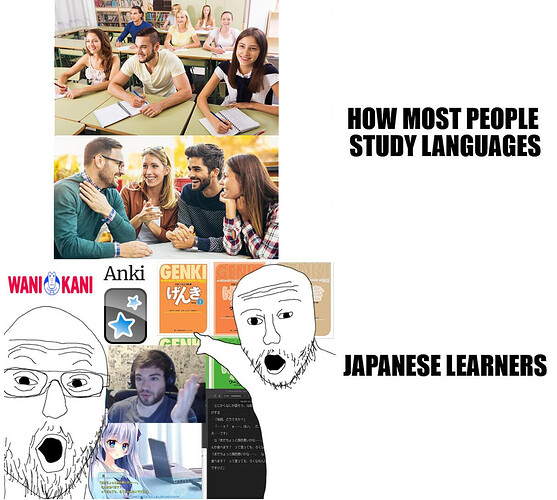.Hello everyone,
I am about to get back into Japanese after giving up a year ago. I know there are tons of posts like this, but I need some specific advice that I can’t find anywhere else. First, a bit of backstory:
I reached level 30 on WaniKani in just one year.
I spent four months in Japan trying to speak every day.
The only grammar resource I ever truly learned was the first book of Minna no Nihongo.
I was hard‑stuck at the same level in Japanese, which ended up demotivating me, and I gave up. After a lot of thinking, the reasons that led to that were the following:
My grammar was too weak, and whenever I tried to learn new grammar points they just didn’t stick (I tried Bunpro, but I couldn’t stick to it, and the same with books). I would just forget what I had learned ten minutes later, even with great effort. Because of this, I could not read manga.
I could not immerse myself enough: I tried watching anime without subtitles but without success. The reason is that WaniKani’s vocabulary is limited and I was missing so much grammar.
This left me stuck between “I need more grammar but I don’t manage to learn it” and “I need useful vocab, but it has to be linked with my WaniKani level.” This hesitation, combined with the fact that current tools could not help me, resulted in my stagnation in Japanese.
To fix this, I would like to start over and learn from my mistakes. I need something where I don’t have to mix resources and that has a clear objective (the WaniKani level system was perfect for me, as I learned so much there). I also need short‑term objectives to see my progress.
My idea is to study for the JLPT and take every level to keep me motivated. For the grammar part, I have no idea how to fix my previous mistake; I tried everything, yet I still couldn’t learn it. I probably just hate grammar, I guess. For vocabulary, I think I can’t brute‑force learn words—I need mnemonic and spaced‑repetition (SSR); WaniKani was absurdly effective. However, since I will be studying for the JLPT, I need to learn vocab and kanji in order. The issue is that every app like WaniKani that has an SSR system either doesn’t follow JLPT order or doesn’t have mnemonics and radicals.
So my questions are:
Do you know a way to learn vocabulary and kanji with radicals and SSR like in WaniKani (I want to learn reading and meaning) following the JLPT order and that includes mnemonics?
Do you have any ideas on how to learn grammar? I think SSR for grammar is not for me. Also I think that Minna no nihongo was too harsh for me so maybe genki will do the job ? My issue is that I would need to learn the vocabulary for each lesson and therefore either the SSR system that I will use will have to follow genki order or I will need to study vocab outside this SSr system which I don't want to.
Thank you so much for reading

 Having fun is half the learning process, and WK’s stickiness is hard to beat.
Having fun is half the learning process, and WK’s stickiness is hard to beat.

